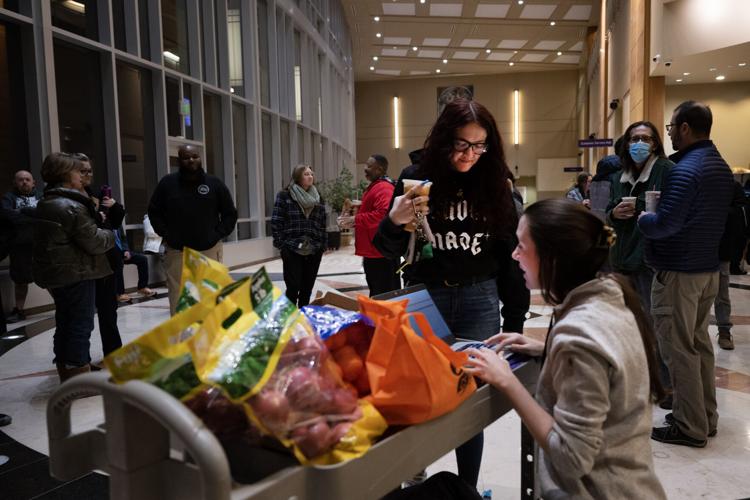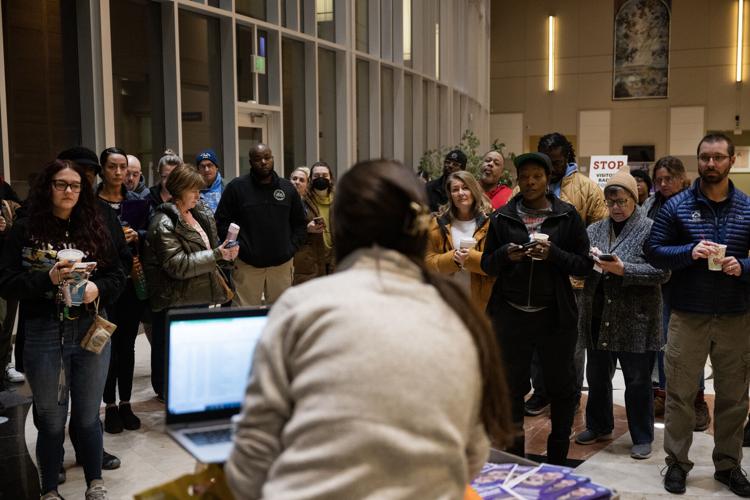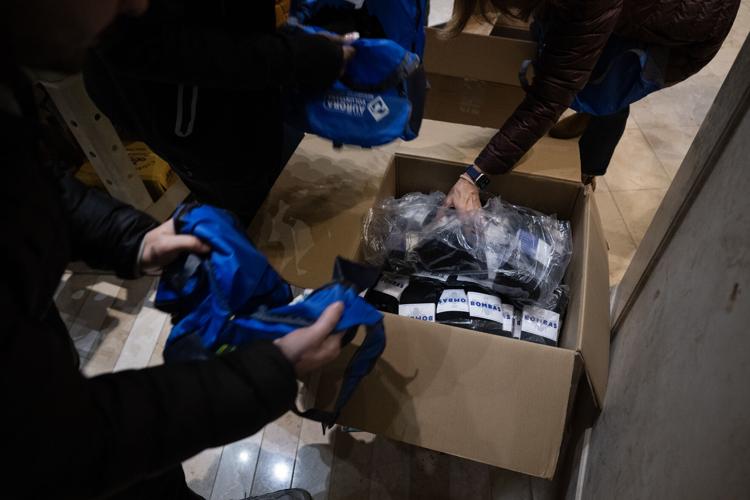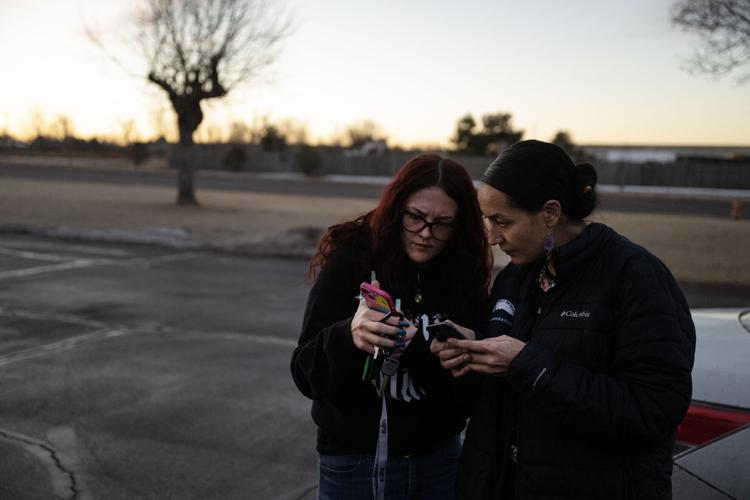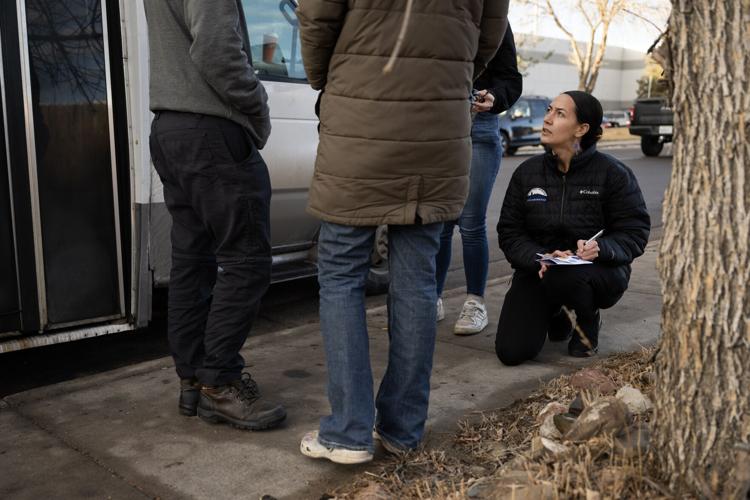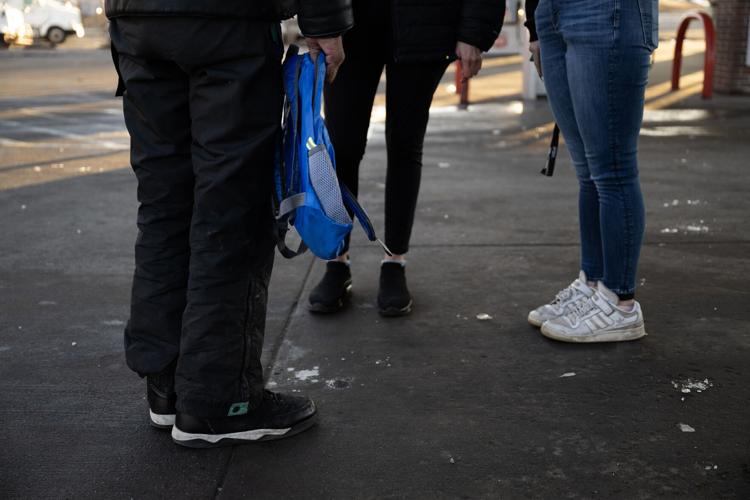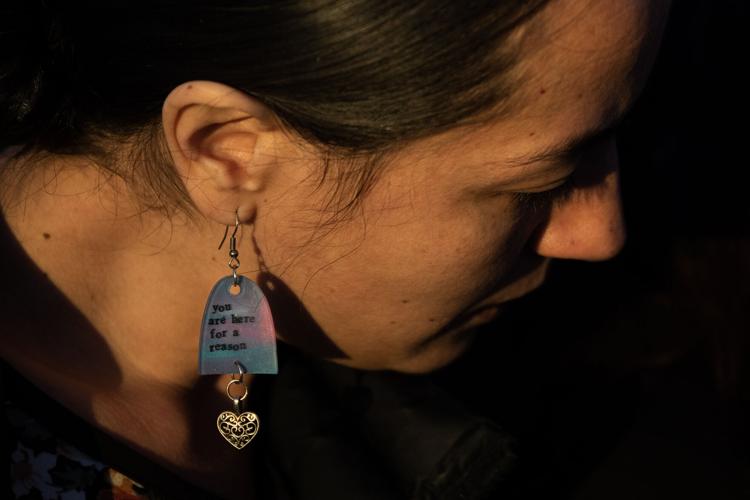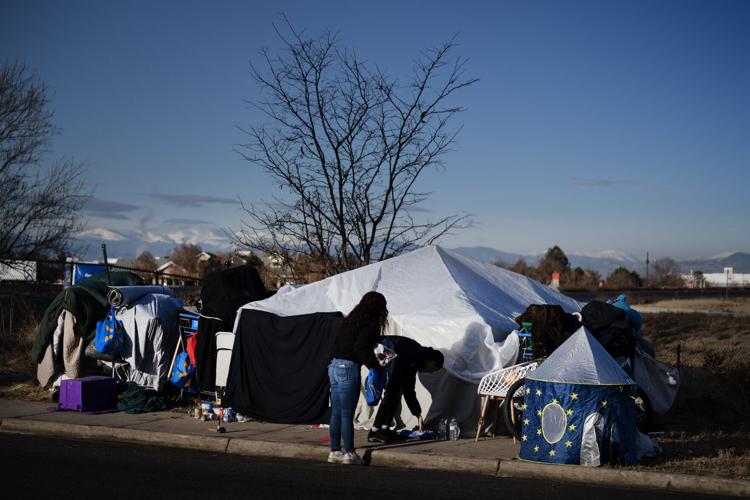More than 70 volunteers show up for Aurora’s 2024 point in time homeless count
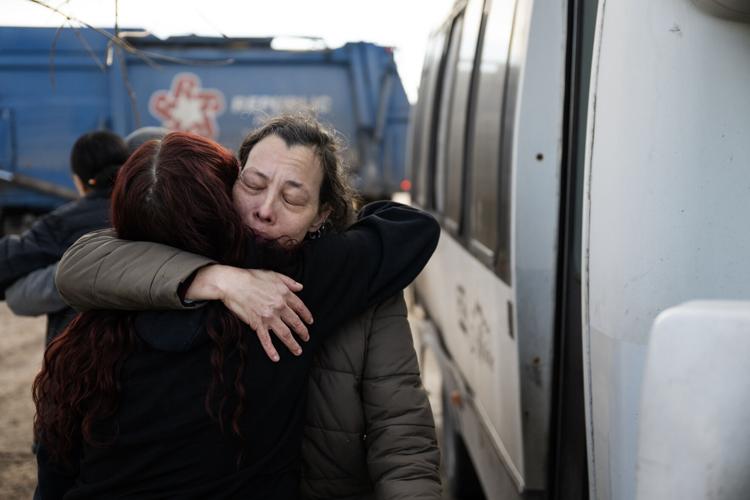
A tear rolls down the cheek of Nashayra Montes-Mercado as she hugs volunteer Madison Magor after Magor and her business partner and fellow volunteer Fatima Kiass surveyed Montes-Mercado and her partner outside of the bus they’ve been living in with their two children and dog during the city of Aurora’s annual point-in-time count on Tuesday, Jan. 23, 2024, in Aurora, Colo. Magor and Kiass gave the couple thick winter socks and a list of resources during the survey, as well as giving them their personal phone numbers for a follow-up visit. (Timothy Hurst/Denver Gazette)
Timothy Hurst/Denver Gazette
“How did you get out of homelessness?”
The question came from Nashayra Montes-Mercado, who asked through tears and hugged Fatima Kiass on Tuesday, crying into her shoulder outside of the small bus she lives in with her partner, Stuart Schwallie, their two children and their dog Ted.
Kiass, one of more than 70 volunteers conducting Aurora’s point in time count on Tuesday morning to get a sense of the number of homeless people in the city, told Montes-Mercado how loved she is and offered her a variety of services to help get her family into more permanent housing.
Montes-Mercado and her family were “rent raised” out of their apartment two years ago and they decided their best financial option was to move into their small van.
Kiass, who had been homeless three times throughout her life, now owns a consulting business, Empowered Connections, to help social workers and homeless people access resources.
It’s not easy, Kiass told her, but it’s possible.
This is why Kiass does what she does, she said.
Homeless people can often become just numbers on the street or places on a housing waitlist, but Kiass — who knows her way around the system and the providers all too well — helps people navigate the resources and figure out what’s right for them.
Kiass and 73 other volunteers, almost twice the number of volunteers for the 2023 PIT count, met before the sun rose at the Aurora Municipal Center, warming up in the building before splitting into groups assigned to different parts of the city.
Each group was tasked with finding homeless people in their designated area, counting them and requesting to survey them, asking questions about the resources they’ve used or not used and where they’re staying.
The idea behind the point in time count, required by the U.S. Department of Housing and Urban Development and conducted each year on a given day in cities and counties across the country, is to get a snapshot of the country’s homeless population on a single night.
Aurora’s count from 2023, taken on Jan. 30, showed a total of 572 homeless people in the city, 409 of whom were “sheltered” — meaning in emergency shelters, transitional housing or safe haven programs — and 163 of whom were “unsheltered.”
The “unsheltered” homeless category refers to people who sleep in public spaces, such as parks or under bridges, as well as in cars.
The count each year directly correlates to the amount of federal funding the city of Aurora gets for services in the community each year, Aurora’s Housing and Community Services Director Jessica Prosser said.
While the count, whose results will likely be made public in October, provides a snapshot of homelessness on a given night in the city, it really is just that — a snapshot, Prosser said.
“You would hope more people are inside seeking shelter in the winter, so while we’re out in the community talking with folks this morning, the same survey is happening in all of our shelters,” Prosser said. “I do think it’s a good snapshot.”
Kiass, who was born and raised in Aurora, said being homeless in college opened her eyes to the lack of resources, especially for college students.
“I was a college student at the time and first generation, so navigating the systems was hard and, as I’m helping out now. I’m realizing those processes haven’t changed,” Kiass said.
For several years, Kiass worked for Urban Peak, an organization that helps homeless youth in Denver. There she saw the need for more support for service providers, which led her to create a business that helps social workers.
Kiass and her business partner, Madison Magor, are working on opening a nonprofit to better support people, as well, Kias said.
“I saw a lot of service providers burning out without enough support,” Kiass said. “I thought, ‘How can I support the folks doing the work so that we can retain the good folks that are doing it?'”
Kiass joined in on the Aurora count Tuesday for both personal and professional reasons.
Having mostly worked with people in Denver, Kiass has a good understanding of homelessness in the area. She is less familiar with Aurora and wanted to know the city better so she can extend help to people.
Assigned to a section of the city, Kiass and Magor drove slowly up and down streets, keeping an eye out for encampments or other signs of homeless people.
Kiass’ experience in outreach has taught her to look near places that offer homeless services and near hotels, gas stations and stores, she said.
The two women took turns approaching people they saw, offering resources, such as water and socks to start the conversation, then asking the people about their situations.
Knowing the system, Kiass was quick to recommend resources to people and sought to ensure people knew how to get help if they wanted it.
While there are resources in Aurora for homeless people, the system is complex and can be difficult to understand, she said.
When people put themselves on a housing waitlist, it doesn’t really help them unless they stay connected with a case manager who can vouch for them, Kiass said. A big part of her job is making sure people know that they need to maintain that connection to be placed in housing.
Otherwise, people end up on a months and even years-long housing waitlist, she said.
Aurora offers between 130 and 150 shelter beds available on any given night, according to the city’s website. The city is up to 8,500 affordable housing units short.
In recent months, Aurora debated funding for homelessness services, with staffers recommending budget cuts for many service providers, in some cases zeroing out the dollars for a few nonprofits in what appears to be a shift in the city’s priorities.
The staff recommendations followed a dip in local government revenue. Specifically, Aurora has seen a significant decrease in marijuana tax funds that support homeless service providers in the city.
Funding cuts are common in the line of work, Kiass said, which is part of why she started taking her own path, with the goal of helping people navigate the complexities of funding and resources.
“My ultimate goal is to bring power back to the people and that’s really just making sure they understand the resources out there and the funding out there,” Kiass said.





